Neural regulation of mechanical digestion- CNS voluntary, ANS & ENS controlled involuntary movements
By: HWC
Date Uploaded: 01/30/2020
Tags: homeworkclinic.com Homework Clinic HWC gastrointestinal Hormonal feedback loops digestive system Neural feedback loops lumen submucosa mucosa submucosal plexus serosa myenteric plexus muscularis food bolus oropharyx Mastication epiglottis hard palate tongue larynx laryngopharynx
• The gastrointestinal [GI] tract is basically a muscular tube that contains and processes food as it moves from the mouth to the anus. • Mechanical digestive functions consist of both voluntary and involuntary muscle contractions and relaxation including: • Chewing and swallowing food. • Mixing and moving food throughout the GI tract. • Elimination of feces. • The propulsive and mixing movement of the smooth muscles in the digestive system are regulated by: • Hormonal feedback loops. • Neural feedback loops. Neural control of the mechanical movements in the GI tract comes from the: • CNS. • ANS (long) reflexes. • ENS (local) reflexes. • The CNS controls voluntary swallowing movements. • The presence of food is the stimulus for voluntary digestive movements. • ANS (long) neural reflexes include a CNS control center in the spinal cord or brain. • ANS neurons regulate involuntary smooth muscular movements. • The stimulus for many involuntary digestive movements is distension. • The response is either increased or decreased contraction of the muscularis. • ENS (or local) reflexes utilize the plexuses embedded in the wall of the GI tract. • ENS reflexes also control involuntary movements of the muscularis. • Mastication, or chewing, is a voluntary process, regulated by the CNS, and performed by muscles above and below the mandible. • Skeletal muscles elevate the mandible, closing the mouth and moving the mandible side to side to chew. • During chewing, food is: • Cut and ground by teeth. • Manipulated by the tongue, lips and cheeks. • Pushed toward the oropharynx.
Add To
You must login to add videos to your playlists.
Advertisement












Comments
0 Comments total
Sign In to post comments.
No comments have been posted for this video yet.